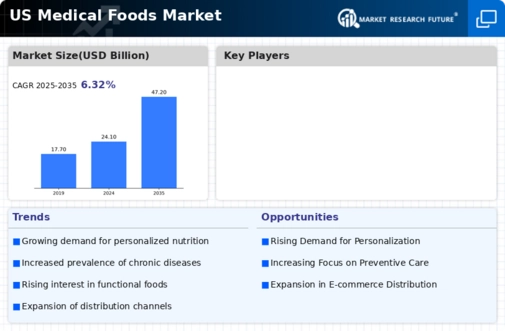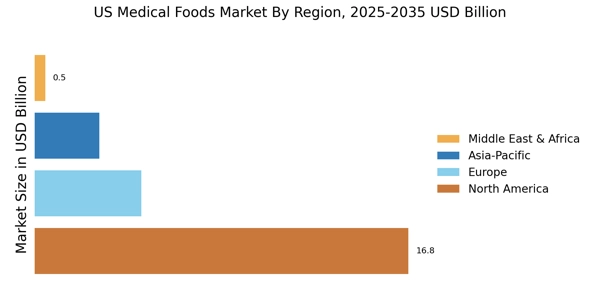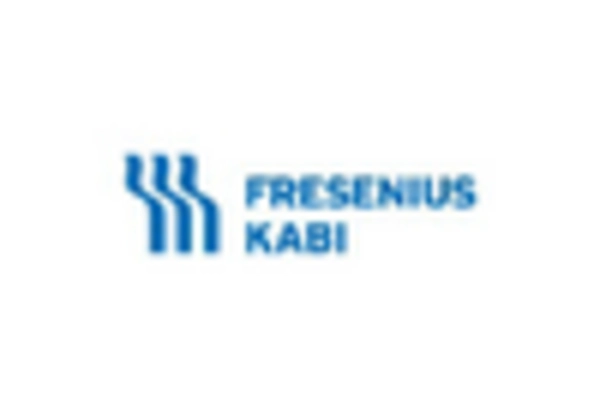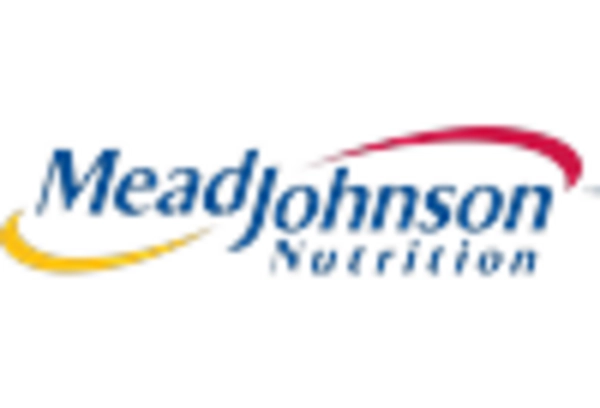Growing Aging Population
The US Medical Foods Market is experiencing a notable surge due to the increasing aging population. As individuals age, they often face various health challenges that necessitate specialized nutritional support. According to the U.S. Census Bureau, the population aged 65 and older is projected to reach 80 million by 2040. This demographic shift is likely to drive demand for medical foods tailored to manage chronic conditions such as diabetes, cardiovascular diseases, and cognitive decline. Consequently, manufacturers are focusing on developing products that cater specifically to the nutritional needs of older adults, thereby expanding their market presence. The growing awareness of the importance of nutrition in managing health conditions further propels this trend, indicating a robust future for the US Medical Foods Market.
Regulatory Support and Guidelines
The US Medical Foods Market is supported by a framework of regulatory guidelines that facilitate the development and marketing of medical foods. The Food and Drug Administration (FDA) provides clear definitions and standards for medical foods, which helps ensure product safety and efficacy. This regulatory clarity encourages manufacturers to invest in research and development, knowing that their products will be subject to rigorous evaluation. Furthermore, the establishment of guidelines for labeling and marketing medical foods enhances consumer trust and awareness. As regulatory bodies continue to support the industry, it is likely that the US Medical Foods Market will experience sustained growth, driven by innovation and consumer demand for safe and effective nutritional solutions.
Rising Prevalence of Chronic Diseases
The US Medical Foods Market is significantly influenced by the rising prevalence of chronic diseases. Conditions such as obesity, diabetes, and hypertension are becoming increasingly common, affecting millions of Americans. The Centers for Disease Control and Prevention (CDC) reports that approximately 6 in 10 adults in the United States have a chronic disease, which underscores the urgent need for effective nutritional interventions. Medical foods designed to address these specific health issues are gaining traction as healthcare providers recognize their potential in managing symptoms and improving quality of life. This trend is likely to continue, as healthcare systems increasingly emphasize preventive care and the role of nutrition in disease management, thereby enhancing the market landscape for medical foods.
Increased Awareness of Nutritional Therapy
The US Medical Foods Market is benefiting from a growing awareness of nutritional therapy among both healthcare professionals and patients. As research continues to highlight the link between diet and health outcomes, there is a shift towards integrating medical foods into treatment plans. Healthcare providers are increasingly recommending medical foods as part of a comprehensive approach to managing various health conditions. This trend is supported by the increasing number of clinical studies demonstrating the efficacy of medical foods in improving patient outcomes. Furthermore, patient education initiatives are fostering a better understanding of the role of nutrition in health, which is likely to drive demand for medical foods. As awareness continues to rise, the US Medical Foods Market is poised for substantial growth.
Technological Innovations in Product Development
The US Medical Foods Market is witnessing a wave of technological innovations that are transforming product development. Advances in food science and technology are enabling manufacturers to create more effective and targeted medical foods. For instance, the use of precision nutrition and personalized formulations is becoming more prevalent, allowing for tailored solutions that meet individual health needs. Additionally, improvements in manufacturing processes and ingredient sourcing are enhancing product quality and efficacy. The integration of digital health technologies, such as apps and wearable devices, is also facilitating better patient engagement and adherence to nutritional regimens. These innovations are likely to attract investment and drive competition within the US Medical Foods Market, ultimately benefiting consumers.


















Leave a Comment